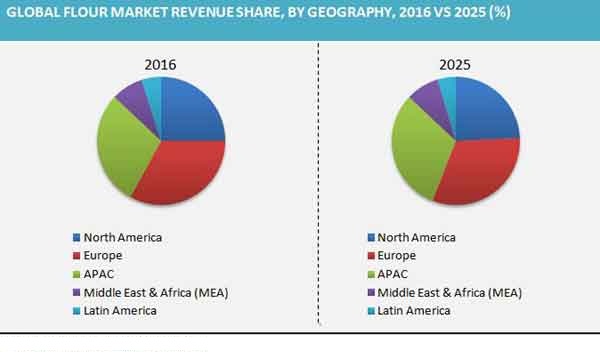The global flour market is projected to reach US $376.15 billion by 2025 in terms of revenue. In 2016, the market was valued at USD 303.50 billion in terms of revenue. In terms of volume, the flour market size was 242,800.0 kilotonnes in 2016 and is expected to reach 284,965.7 kilotonnes by 2025.
Table of Contents
Flour Market Analysis – Description
Flour is a powdered raw material used for producing breads, bakery products, noodles, wafers, crackers, confectionery items, etc. Flours are produced by grinding cereals, grains, roots and seeds. Wheat flour is the most common base material used for the production of bread products.

The market for flour has been covered under the scope of this report. Flour is a powdered base material used for the production of different bakery products, confectionary items, wafers, noodles, and animal feed, among others. Wheat, rice, maize, and rye are primarily being used as raw materials for the production of flour. The flour market has been segmented on the basis of raw material, application, and region. It also provides a cross-sectional study of the global flour market across broad regional segments such as North America, Europe, Asia-Pacific (APAC), Middle-East & Africa (MEA), and Latin America under its scope. The market is primarily being driven by the rising demand for flour-based bakery products among consumers of different age groups and the growing consumption of flour-based noodles and pasta in Asian countries. In addition, growth in animal feed applications of flour is also driving the growth of the market.
The scope of the Report
A complete analysis of market dynamics, which includes the market drivers, restraints, and opportunities, is included within the scope of the report. Market dynamics for the different segments, namely raw materials and applications, have been covered separately under the purview of the report. Additionally, the country-level trend for each region has also been covered under the scope of the report. Thus, this report provides an exhaustive study of the global flour market and also provides a forecast of the market for the period from 2017 to 2025.
Analysis Covered in the Report
Within the scope of the report on the global flour market, several high-level analyses have been covered. This includes product-market trend analysis, product life-cycle analysis, Porter’s five forces analysis, and market attractiveness analysis. Key trends analysis discusses the current and upcoming trends in this market. Product life-cycle analysis analyses the current life-cycle stage of the product in the five wide geographic regions, such as whether the product is approaching maturity in a region or whether it is a new entrant, etc. Porter’s five forces analysis provides insights into the competitive scenario with regards to new entrants, substitutes, buyers, and suppliers. To provide a detailed insight into the global flour market, the market attractive analysis has been provided in the report. Market attractiveness analysis details the investment attractiveness of each raw material, application, and geography.

Market Dynamics
The primary driving factors of the flour market are increasing consumption of bakery products, flour-based fast food items, and the rising use of flour in the preparation of animal feed. The growing demand for flour-based noodles in South Asian countries is also driving the growth of the market. Additionally, growing demand for gluten-free variants of flour such as white rice flour, barley flour, maize flour, corn flour, and soya flour among health-conscious consumers is also triggering the growth of the flour market size. Furthermore, growing usage of flour in the production of roux, bioplastics, and baby foods has also provided a boost to the growth of the market. Considering the positive impacts of the aforementioned factors, the demand for flour is expected to rise during the forecast period from 2017 to 2025.
Segmentation Overview
Based on Raw Materials

In terms of raw material, the market has been segmented into wheat, maize, rice and others. Others include oat and rye flour. In 2016, in terms of revenue and volume, wheat was the largest raw material segment in global flour market.
- Wheat
- Maize
- Rice
- Others
Based on Application

Based on application, the flour market has been segmented into bakery, noodles and pasta, biscuits, crackers and wafers, animal feed, and others. Others include non-food applications such as bioplastics, glue, and biomaterials. As of 2016, bakeries contributed the largest revenue as well as volume share of the market. Growing consumption of flour-based bakery products in Asian countries and rising demand for bread-based fast foods across the younger generation and working professionals are the prime reasons behind such a large market share.
- Bakery
- Noodles and Pasta
- Biscuits, Crackers, and Wafers
- Animal Feed
- Others
Flour Market, by Region
- North America
- The U.S.
- Canada
- Europe
- The U.K
- Germany
- Italy
- Scandinavia + CIS
- Rest of the Europe
- Asia Pacific
- China
- Japan
- India
- ASEAN
- Rest of the Asia Pacific
- Middle-East & Africa (MEA)
- Egypt
- The United Arab Emirates
- South Africa
- Rest of the MEA
- Latin America
- Brazil
- Mexico
- Argentina
- Rest of the Latin America
The Competitive Profiling
The competitive profiling of the key players in the global flour market and their business segments have been exhaustively covered under the purview of the study. Moreover, the specific business strategies of key players in the market have also been covered in the report.
Some major players in the Flour Market
Some major players in the market are: Archer Daniels Midland Company (The U.S.), Associated British Foods plc (The U.K), General Mills, Inc. (The U.S.), ConAgra Foods, Inc. (The U.S.), King Arthur Flour Company, Inc. (The U.S.), Unilever (The U.K), ITC Limited (India), Hodgson Mill (The U.S.), Cargill, Inc. (The U.S.) and Bunge Limited (The U.S.) among others.
Regional Outlook

The global flour market has been further segmented into five broad geographic regions, namely North America, Europe, Asia Pacific (APAC), Middle East and Africa (MEA), and Latin America. In 2016, Europe occupied the largest revenue share of the market. The large market share can be attributed to the huge consumption of bread-based products, the strong presence of leading players and the wide applications of different variants of flour.



